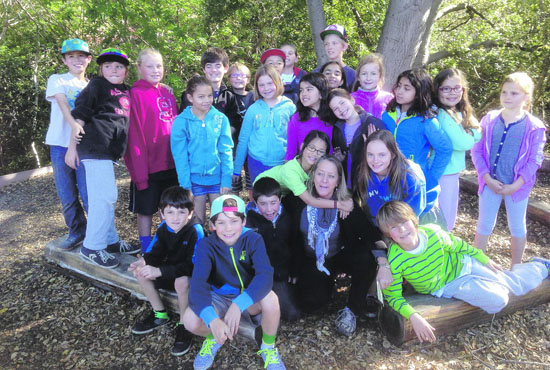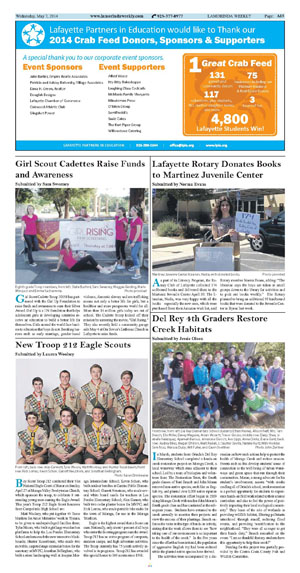|
|
Published May 7th, 2014
|
Del Rey 4th Graders Restore Creek Habitats
|
|
| Submitted by Jessie Olson |
 |
| Front row, from left: Del Rey Elementary School students Ethan Haines, Allison Neff, Mrs. Terri Brasch, Ella Miller, Davey Maguire, Aidan Mccartt, Trevor Grosso; middle row: Daisy Shea, Isabella Velazquez, Apameh Berloui, Annaluna Giacich, Ava Lippi, Anna Crinks, Elena Gant; back row: Audrey Biles, Megan Dhillon, Matt Radell, JJ Sautter Savilla, Natalie Kurtz,Willy Hodder, Sam Ross, Marissa Duby, Will Fuller, and Gavin Boettner. Photo John Zentner |
In March, students from Orinda's Del Rey Elementary School completed a hands-on creek restoration project on Moraga Creek, a local waterway which runs adjacent to their school. Led by a team of biologists and volunteers from The Restoration Trust, the fourth grade classes of Terri Brasch and John Moran removed non-native species, such like as English ivy, and planted over 1,000 native riparian species. The restoration effort began in 2009 along Moraga Creek with teacher John Moran's fourth grade class and has continued in the subsequent years. Students have returned to the creek annually to monitor their projects and view the success of their plantings. Brasch enforces the value in this type of hands-on activity, stating that the work allows them to see "how taking care of our environment is so important to the health of the creek." In the five years since the effort has been initiated, the population of aggressive English ivy had been reduced while the planted native species have thrived.
 The activities were accompanied by a discussion on how such actions help to protect the health of Moraga Creek and reduce erosion. Events such as this develop students' sense of connection to the well-being of urban waterways and green space that run through their communities. Moran, a strong advocate for his student's involvement, asserts "with creeks cradling all of Orinda's school, creek restoration is a perfect opportunity for students to experience hands-on field work related to their science curriculum and also to feel the power of positively impacting their local ecological community." They learn of the role of wetlands in providing wildlife habitat, filtering pollutants introduced through runoff, reducing flood events, and providing beautification to the neighborhood. "They were all so eager to get their hands dirty," Brasch remarked on the event. "I am so thankful that my students have this opportunity to help their creek!"
The activities were accompanied by a discussion on how such actions help to protect the health of Moraga Creek and reduce erosion. Events such as this develop students' sense of connection to the well-being of urban waterways and green space that run through their communities. Moran, a strong advocate for his student's involvement, asserts "with creeks cradling all of Orinda's school, creek restoration is a perfect opportunity for students to experience hands-on field work related to their science curriculum and also to feel the power of positively impacting their local ecological community." They learn of the role of wetlands in providing wildlife habitat, filtering pollutants introduced through runoff, reducing flood events, and providing beautification to the neighborhood. "They were all so eager to get their hands dirty," Brasch remarked on the event. "I am so thankful that my students have this opportunity to help their creek!"
 Funding for this project was partially provided by the Contra Costa County Fish and Wildlife Committee.
Funding for this project was partially provided by the Contra Costa County Fish and Wildlife Committee.

|
|
|
|
|
|
|
|
|
| |
|
|
|
|



